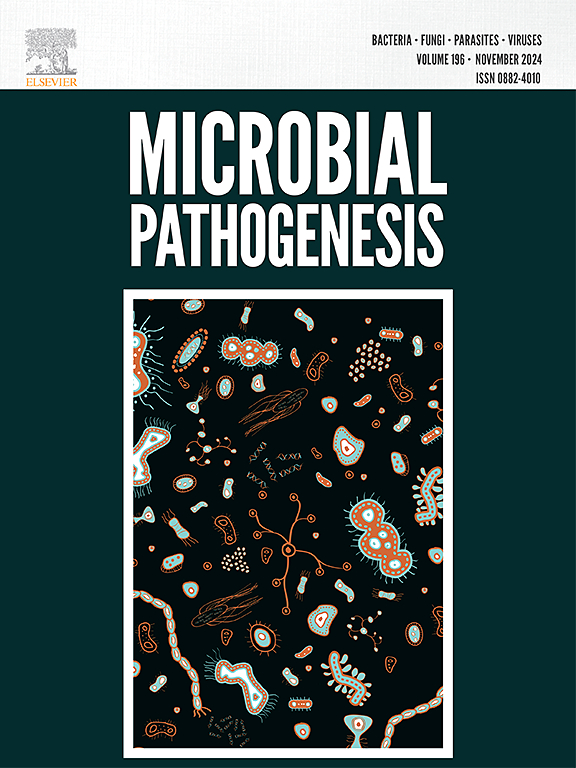子囊病毒密码子使用偏好的全基因组分析:对病毒进化和宿主适应的见解
IF 3.5
3区 医学
Q3 IMMUNOLOGY
引用次数: 0
摘要
子囊病毒是一种环状双链DNA病毒,可感染鳞翅目动物,产生大的包膜病毒粒子,并引起具有细胞凋亡样细胞病理学的慢性致命疾病。了解子囊病毒密码子的使用模式有助于揭示宿主与病毒的相互作用、进化压力、基因表达优化等问题。然而,尚未对Ascovirus (Ascovirus科的一个属)基因组中的密码子使用偏差(CUB)进行彻底的分析。本文利用9种Ascovirus属病毒的完整基因组,对它们的密码子使用模式进行了系统分析。结果显示,与G和C相比,a和T的平均核苷酸组成更高,特别是在第三个密码子位置上,偏爱a /T核苷酸。此外,结果表明Ascovirus具有较低的CUB。二核苷酸组成显著影响子囊病毒密码子的使用模式。通过ENC图、中性图、宇称规则2 (PR2)分析、对应分析和相关分析,进一步证实突变压力对密码子使用的影响比自然选择更显著。密码子适应指数(CAI)分析表明,Ascovirus对宿主具有较强的适应性。我们的研究结果阐明了子囊病毒基因组密码子的使用模式,为这些病毒的基础进化研究提供了必要的原始数据。本文章由计算机程序翻译,如有差异,请以英文原文为准。
Genome-wide analysis of codon usage bias in Ascovirus: Insights into viral evolution and host adaptation
Ascoviruses are circular double-stranded DNA viruses that infect lepidopterans, producing large enveloped virions and causing a chronic, deadly disease with apoptosis-like cytopathology. Understanding the codon usage patterns of ascoviruses could shed light on host-virus interactions, evolutionary pressure, gene expression optimization. Nevertheless, thorough analyses of codon usage bias (CUB) within the genomes of Ascovirus (a genus in the Ascoviridae family) have yet to be conducted. Herein, a systematic analysis was performed to clarify the codon usage patterns in nine viruses of the Ascovirus genus, using their complete genomes. The results revealed a higher average nucleotide composition for A and T compared to G and C, with a preference for A/T nucleotides, particularly at the third codon position. Moreover, the results indicated that Ascovirus has a relatively low CUB. Dinucleotide composition significantly influences the codon usage patterns in Ascovirus. Further analyses, including ENC plot, neutrality plot, parity rule 2 (PR2) analysis, correspondence analysis, and correlation analysis, confirmed that mutational pressure had a more significant influence than natural selection in shaping codon usage. Codon adaptation index (CAI) analysis indicated that Ascovirus is strongly adapted to its hosts. The results of our study illustrated the codon usage patterns in Ascovirus genomes and provided essential primary data for foundational evolutionary research on these viruses.
求助全文
通过发布文献求助,成功后即可免费获取论文全文。
去求助
来源期刊

Microbial pathogenesis
医学-免疫学
CiteScore
7.40
自引率
2.60%
发文量
472
审稿时长
56 days
期刊介绍:
Microbial Pathogenesis publishes original contributions and reviews about the molecular and cellular mechanisms of infectious diseases. It covers microbiology, host-pathogen interaction and immunology related to infectious agents, including bacteria, fungi, viruses and protozoa. It also accepts papers in the field of clinical microbiology, with the exception of case reports.
Research Areas Include:
-Pathogenesis
-Virulence factors
-Host susceptibility or resistance
-Immune mechanisms
-Identification, cloning and sequencing of relevant genes
-Genetic studies
-Viruses, prokaryotic organisms and protozoa
-Microbiota
-Systems biology related to infectious diseases
-Targets for vaccine design (pre-clinical studies)
 求助内容:
求助内容: 应助结果提醒方式:
应助结果提醒方式:


